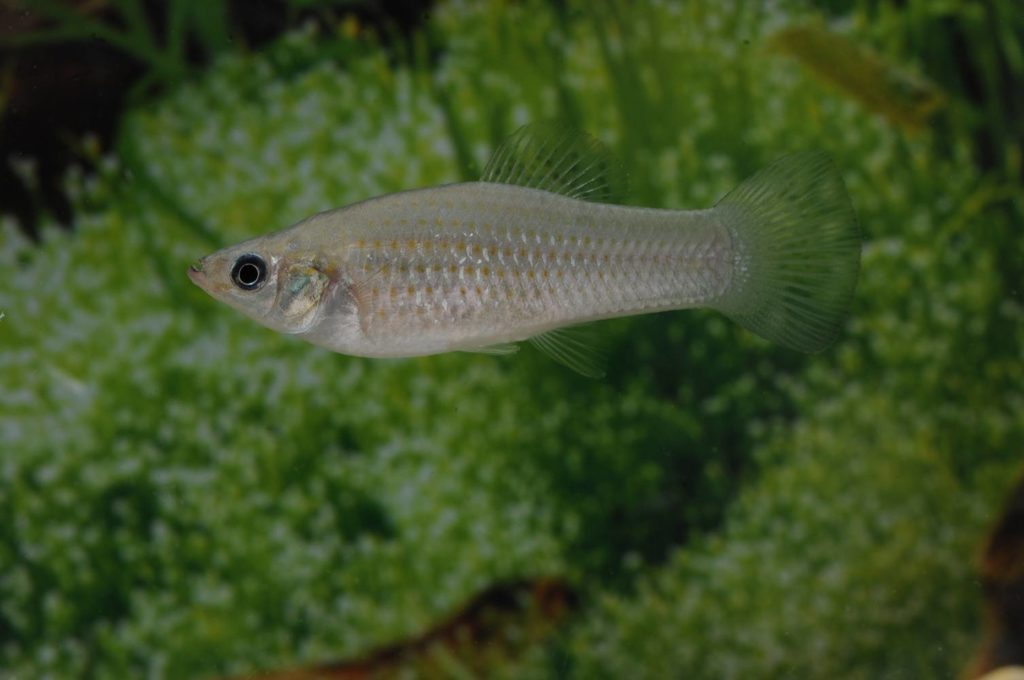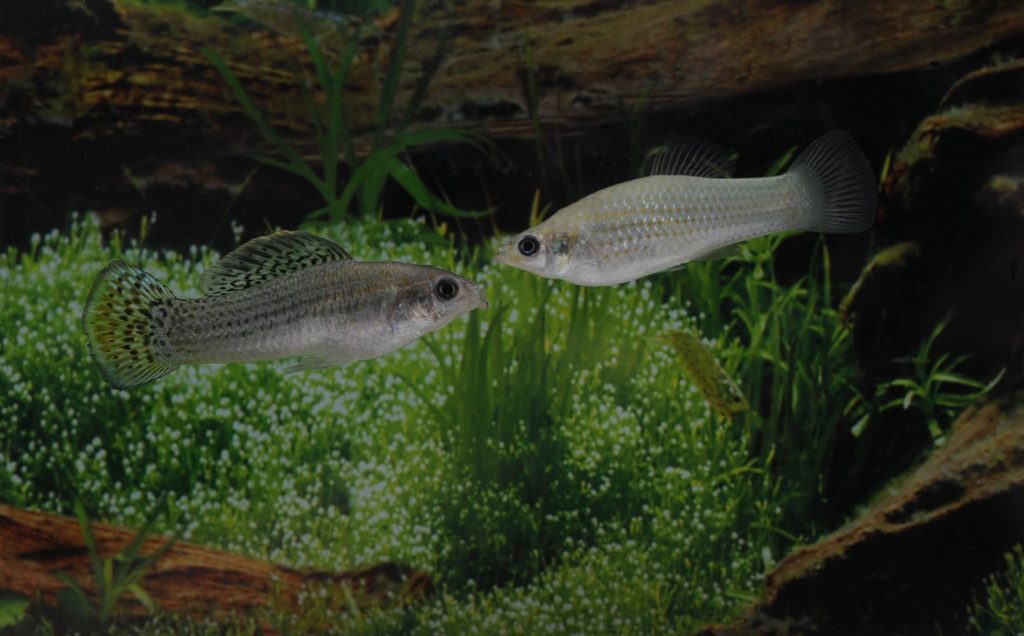Texas A&M Biologist Leads International Team That Sequences First Amazon Molly Fish Genome

Highlights
- The Amazon molly has flourished by defying nature’s odds to reproduce asexually, cloning themselves by duping the male fish of another species to waste their germplasm
- Females steal the entire genome of their host males, keep it for one generation and then throw it out again
- The existence of Amazon mollies back anywhere from 100,000 to 200,000 years ago to a sexual reproduction event involving two different species of fish
- Faculty Fellow Dr. Manfred Schartl led the international team that recently sequenced the first Amazon molly fish genome
No species is immune from the suffering of unrequited love, but scientists expect to learn volumes about the biological basis of sex from the newly sequenced genome of an all-female, asexual Texas native – the Amazon molly fish – that has thrived as a master of male manipulation over millennia.
The fresh waters along the Texas-Mexico border serve as home to this evolutionary anomaly – a fish that has flourished by defying nature’s odds to reproduce asexually through a natural form known as parthenogenesis in which growth and development of embryos occurs without fertilization, resulting only in daughters that are true clones of their mothers.
Texas A&M University Hagler Institute for Advanced Study (HIAS) Faculty Fellow Dr. Manfred Schartl led the international team that recently sequenced the first Amazon molly genome and the genomes of the original parental species that created this unique fish in an effort to better understand how its reproduction deviates from the male-female sexual norm and why the Amazon molly as a species has fared so well in the process.
The evolution of sex
The findings from their National Institutes of Health-funded research are published online today (Feb. 12) in the Nature research journal Nature Ecology & Evolution.
“The existence of two sexes, male and female, is one of the oldest and most widespread phenomena in biology,” says Schartl, a world leader in cellular and molecular biology of Xiphophorus model systems including platyfish and swordtails. “Studies on the exceptional case of asexuality helps us to better understand the biological meaning and evolution of sex.”
Animals that reproduce asexually are rare, compared to the overwhelming majority of species that exist as males and females and reproduce sexually. Because it was long thought that vertebrates would not be able to exist in such a way, Schartl says it was a sensation when the Amazon molly was the first asexual vertebrate discovered in 1932.
But even the most independent females occasionally need a male – in the Amazon molly’s case, to kick-start the parthenogenesis process. They seduce males from related sexual species for this service, which Schartl notes lacks the regular benefit for these males, which do not contribute their genes to the next generation.

Thriving by cloning
“In essence, mollies repeatedly clone themselves by duping the male fish of another species to waste their germplasm,” Schartl says. “This reminds one of the tribe of female warriors in the Greek mythology, from which their name is derived.”
The team’s research traces the existence of Amazon mollies back anywhere from 100,000 to 200,000 years ago to a sexual reproduction event involving two different species of fish, an Atlantic molly and a Sailfin molly.
“That’s about 500,000 generations if you calculate it out to the present day, which makes them genetically older than humans,” Schartl says. “This is unexpected because asexuals are expected to be at disadvantage compared to their sexual counterparts.”
Schartl notes that one of the theories as to why asexual reproduction is incompatible with a species’ sustainability is the idea that if no new DNA is introduced during reproduction, then harmful gene mutations can accumulate over successive generations, leading to eventual extinction. Another hypothesis states that asexual reproduction is not like sexual reproduction, where the different genomes of the two parents are newly combined and create new genomes with every offspring. Because the absence of recombination in asexuals limits genetic diversity within a species, he says it gets more and more difficult to adapt to changes in the environment.
“Unexpectedly, we did not find the signs of genomic decay as predicted,” Schartl adds. “Our findings suggest that the molly’s thriving existence can be explained by the fact that the fish has a hardy genetic makeup that is often rare in nature and gives the animals some survival benefits.”
Schartl says the hybridization of the Atlantic and Sailfin mollies’ two different species genomes into a new one created a situation well known in the animal and plant breeding world — an artificial hybrid that is bigger, more colorful and capable of generating more and better products than the purebred parents, a phenomenon known as hybrid vigor.
Texas A&M Professor’s Study Of Darwin’s Finches Reveals Species Can Evolve In Two Generations
The key to successful hybridization
“We found the signature of such hybrid vigor in the genome of the Amazon molly,” Schartl explains. “Moreover, in studying the genomes of individual Amazon mollies from all over their natural range, we detected a considerable genetic variability of clones that have diverged since the single species cross that produced the so-called ‘Eva of the Amazons.’ This genetic diversity was particularly obvious when we looked at the genes that make up the immune system and are required to fight diseases and parasites.”
As impressive as the Amazon molly’s sexual self-reliance is, Schartl cautions that the team’s research leads them to believe it’s less probable than the odds of finding true love.
“The successful hybridization of two genomes from different species appears to be a random event that would require nearly perfect compatible genomic elements to bypass sexual reproduction,” he explains. “The probability that such an event happens is rare, to the extent that successful asexuals emerge only once in thousands of vertebrate species.”
While the Amazon molly adopted an atypical mode of reproduction in borrowing sperm from males of a related species, Schartl says there is another asexual fish that goes one step further.
“These females steal the entire genome of their host males, keep it for one generation and then throw it out again,” he says. “The genome of this fish is target of a collaboration that I started with Texas A&M biologists Mariana Mateos and Gil Rosenthal.”
Schartl, professor and head of the Department of Physiological Chemistry at the University of Würzburg, Germany, is a visiting professor in the Texas A&M Department of Biology, where he continues to collaborate with Rosenthal, along with faculty, research scientists and graduate students in the Texas A&M Health Science Center and Texas A&M College of Veterinary Medicine and Biomedical Sciences.
A member of the National Academy of Sciences of Germany and a recipient of the Heisenberg Award from the German Research Foundation, Schartl is globally renowned for his career work explaining the molecular-genetic basis of cancer formation using non-mammalian models and for translating basic evolutionary research into discoveries with clear and direct impacts on human health. He has elucidated key mechanisms in swordtail fish whereby genetic variation generates variation in physical traits and also addressed important questions surrounding the development of melanoma in interspecific hybrids of these fish while taking a lead role in sequencing the first genome in the genus.
The team’s paper, Clonal polymorphism and high heterozygosity in the celibate genome of the Amazon molly, can be viewed online along with related figures and captions.
###
Media contact: Shana K. Hutchins, (979) 862-1237 or shutchins@science.tamu.edu or Dr. Manfred Schartl, 931-31-84148 or phch1@biozentrum.uni-wuerzburg.de.





